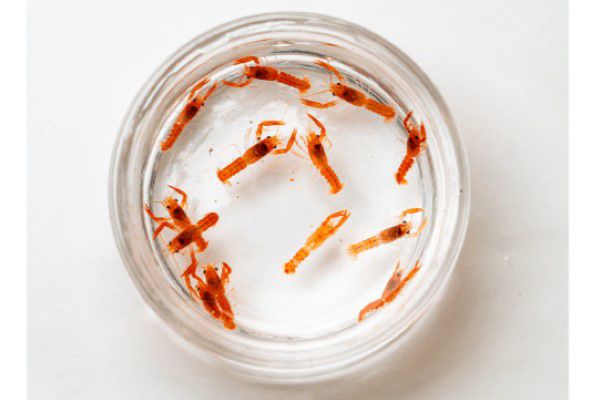Baby lobsters at UNE will help inform novel DNA research study
 |
|
More than a dozen orange lobster larvae. PHOTO CREDIT: MARKUS FREDERICH/UNE
|
The University of New England is the home of two families of tiny, baby lobsters — dozens of them, each no larger than a thumbtack — which are currently being raised and studied by students and faculty as part of an ongoing, novel research project into the genetic basis for their rare coloration.
Miniature crustaceans in various shades of brown, blue, and orange have taken up residence in the University’s Arthur P. Girard Marine Science Center. There are currently 140 of these small lobsters, which hatched earlier this summer and have been molting and growing ever since.
They are the offspring of two adult female lobsters who also call UNE home: Peaches, a rare, 1-in-30-million orange lobster who captured hearts everywhere when she arrived at UNE last year, and Norma, a typical brown or “mottled” lobster, who arrived at UNE in June.
The arrival of these baby lobsters in a spectrum of colors — from typical brown to ultra-rare orange and blue — to the Girard Marine Science Center will help student and faculty researchers uncover the molecular basis for the variations in shell color that have led these rare lobsters to international acclaim.
At least 40 of Peaches’ offspring share her orange coloration
Studying their genetic traits is UNE undergraduate Ruby Motulsky (Marine Sciences, ’25), a student in the Invertebrate Physiology Lab of Markus Frederich, Ph.D., professor of marine sciences.
Motulsky, who uses they/them pronouns, was awarded $5,000 from the Bioscience Association of Maine to fund their summer research to examine the number of lobsters that share their mothers’ coloration, the study of heritable traits known as epigenetics. The work is part of a larger effort launched by Frederich this winter to decode the molecular basis for rare lobster coloration through noninvasive methods.
With its reputation for excellence in the marine sciences, UNE has become a magnet for rare lobsters in recent years, housing an impressive lineup including blue, orange, yellow, split-colored, purple, and calico varieties — each with rarity ranging from 1-in-1 million to 1-in-50 million.
The baby lobsters currently being raised at UNE — 100 from Peaches and 40 from Norma — will soon have even more siblings. Pineapple, another rare orange lobster housed at UNE, is currently bearing eggs that are expected to hatch next spring.

